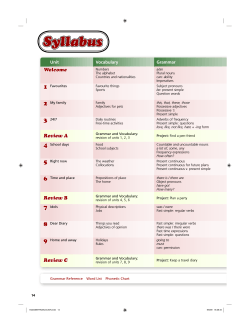
Formal Languages and Automata Theory Exercises Languages and
Formal Languages and Automata Theory
Formal Languages and Automata Theory
Exercises Languages and Formal Grammars
Unit 4 – Part 1
Authors:
Araceli Sanchis de Miguel
Agapito Ledezma Espino
Jose A. Iglesias Martínez
Beatriz García Jiménez
Juan Manuel Alonso Weber
* Several exercises are based on the ones proposed in the following books:
Enrique Alfonseca Cubero, Manuel Alfonseca Cubero, Roberto Moriyón Salomón.
Teoría de autómatas y lenguajes formales. McGraw-Hill (2007).
Manuel Alfonseca, Justo Sancho, Miguel Martínez Orga. Teoría de lenguajes,
gramáticas y autómatas. Publicaciones R.A.E.C. (1997).
Pedro Isasi, Paloma Martínez y Daniel Borrajo. Lenguajes, Gramáticas y Autómatas.
Un enfoque práctico. Addison-Wesley (1997).
Formal Languages and Automata Theory
1. Create a grammar to generate the following languages:
a. { a, aa, aaa }
b. { a, aa, aaa, aaaa, aaaaa, …)
c. { λ, a, aa, aaa }
d. { λ, a, aa, aaa, aaaa, aaaaa, …)
The notation used to denote each one of the languages is:
a. { an | n [1, 3] }
b. { an | n > 0 }
c. { an | n [0, 3] }
d. { an | n≥ 0 }
2. Given the grammars G=({c,d}, {S,A,T}, S, Pi}where:
Determine the associated language.
3. Create a grammar to generate the following languages:
a. { an bn | n > 0 }
b. { an bm | n > 0, 0 < m < n }
c. { an bm | n > 0, 0 ≤ m < n }
4. Determine the type of the following grammars into the Chomsky Hierarchy. Justify
your answer.
a. G=({a,b}, {A,B,S}, S, P), P={S::=aA, A::=bB, A::=aA, A::=a, B::=λ}
b. G=({a,b,c}, {A,B,C,S}, S, P), P={S::=aAb, S::=Ba, S::=λ, aAbC::=aAbB,
aAbC::=aabC, BCc::=AaCc, BCc::=BaAbc, C::=Ca, C::=a}
c. G=({house, garden, cat}, {S, CASTLE, FOREST, TIGER}, S, P),
P={ S::=TIGER garden, S::=FOREST CASTLE, FOREST::=λ, garden
CASTLE TIGER house::=garden FOREST TIGER house, cat CASTLE
FOREST ::=cat FOREST house TIGER FOREST, FOREST::=TIGER house,
FOREST::=garden}
d. G=({x,y}, {C,A,B,S}, S, P), P={S::=Cx, S::=Cy, S::=By, S::=Ax, S::=x,
S::=y, A::=Ax, A::=Cx, A::=x, B::=By, B::=yA, C::=xA}
e. G=({a,b,c}, {S,B}, S, P), P={S::=abc, S::=aBSc, Ba::=aB, Bb::=bb}
Formal Languages and Automata Theory
5.
Given the grammar G,
G=({a,b,c}, {S,A,B}, S, P), P={S::=λ, S::=aAc, A::=aA, A::=Ac, A::=B, B::=b, B::=Bb}
It is required:
a. Specify the type of G in the Chomsky Hierarchy. Justify your answer.
b. Determine the language L generated by the grammar.
c. Construct two different derivation trees for a word in L(G).
d. Verify if the following sentential forms are valid in G, and write a derivation
chain to generate the valid ones.
1) aaAcc
2) ac
3) ababBcc
4) abbccc
6. Obtain the grammar corresponding to the language L={anbmcpaqbn, tal que q=p+m;
n,m≥1; p≥0}
7. Obtain a grammar for the language with alphabet {a, b, c, d} that consists of all the
strings that can be formed by combining these symbols except those that contain the
substring“bc”.
8. Obtain a grammar for the language L = {xnymzk | m, n, k ≥0, k=m+n }
9. Obtain a grammar for the language {abna / n=0, 1, …}
10. Obtain a type-0 grammar for the language L={anbncn} where n≥1.
11. Obtain the language generated by the grammar G=({0,1},{S,A,B,C},S,P), where P:
S BAB
BA BC
CA AAC
CB AAB
A0
B 1
12. Design a grammar to generate natural numbers.
© Copyright 2025











